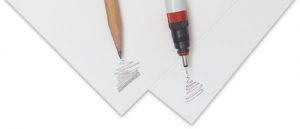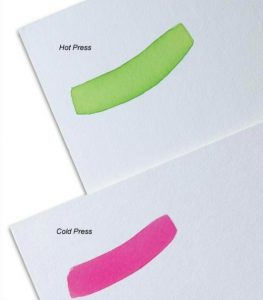Pen-and-ink Drawing Surfaces
Pen-and-ink drawings are usually created on different types of paper. The tooth or grain of the paper can affect the marks made by the pen. Because of this, most illustrators prefer to work on smoother surfaces that are still absorbent to the ink, creating detailed ink drawings in this way.
You can use ink to draw on your sketchbook paper, but over time this paper will warp or fray with the wetness of the ink. The paper in this sketchbook simply isn’t heavy or absorbent enough. For final work, illustrators usually choose something with a little more heft.
Paper
Bristol Board is a smooth-surfaced paper that’s heavier than regular drawing paper. It’s a popular choice for pen-and-ink drawings.
Another popular choice for ink drawings, and the paper used for this class, is hot-press watercolor paper. Hot press refers to the method used to make this special kind of paper. This paper’s surface has been ironed smooth, and is very versatile, allowing artists to make fine details in ink as well as combine other media such as watercolors or colored pencils.






Pingback: Reading on INKING | COMD 2313 Illustration 1, SP2018
its most ideal to use smooth paper like bristol or hot press paper to ink because sketch book paper “over time will warp or fray with the wetness of the ink.”
I’ve learned that using sketchbook paper for inking a final piece is not the best solution. The sketchbook paper doesn’t absorb the ink very well and it can fray. Using Bristol or hot press paper is the best option for inking.
I learned most illustrators work with smooth paper material that will absorb well and become very detailed for their ink drawings. Using ink on sketch paper can be used, but is not highly recommended considering that over time the paper will fray or warp with the wetness of the ink. Another great paper to use for inking is hot press watercolor paper because of it’s iron smooth surface, creating a more fine detailed ink drawing.
I learned most illustrators work with smooth paper material that will absorb well and become very detailed for their ink drawings. Using ink on sketch paper can be used, but is not highly recommended considering that over time the paper will fray or warp with the wetness of the ink. Another great paper to use for inking is hot press watercolor paper because of it’s iron smooth surface, creating a more fine detailed ink drawing.
After reading this I learned that artists tend to use thick and hot pressed watercolor paper for inking. Using thin paper isn’t exactly a good idea for inking because thin paper does not absorb ink to well. Bristol board is good for inking because it is thick and absorbs ink very well.
After reading this I learned that artists tend to use thick and hot pressed watercolor paper for inking. Using thin paper isn’t exactly a good idea for inking because thin paper does not absorb ink to well. Bristol board is good for inking because it is thick and absorbs ink very well.
After reading this I learned that artists tend to use thick and hot pressed watercolor paper for inking. Using thin paper isn’t exactly a good idea for inking because thin paper does not absorb ink to well. Bristol board is good for inking because it is thick and absorbs ink very well.
After reading this I learned that artists tend to use thick and hot pressed watercolor paper for inking. Using thin paper isn’t exactly a good idea for inking because thin paper does not absorb ink to well. Bristol board is good for inking because it is thick and absorbs ink very well.
After reading this I learned that artists tend to use thick and hot pressed watercolor paper for inking. Using thin paper isn’t exactly a good idea for inking because thin paper does not absorb ink to well. Bristol board is good for inking because it is thick and absorbs ink very well.
After reading this I learned that artists tend to use thick and hot pressed watercolor paper for inking. Using thin paper isn’t exactly a good idea for inking because thin paper does not absorb ink to well. Bristol board is good for inking because it is thick and absorbs ink very well.
After reading this I learned that artists tend to use thick and hot pressed watercolor paper for inking. Using thin paper isn’t exactly a good idea for inking because thin paper does not absorb ink to well. Bristol board is good for inking because it is thick and absorbs ink very well.
After reading this I learned that artists tend to use thick and hot pressed watercolor paper for inking. Using thin paper isn’t exactly a good idea for inking because thin paper does not absorb ink to well. Bristol board is good for inking because it is thick and absorbs ink very well.
Why comment 5 times?
Why comment 5 times?
Why comment 5 times?
drawings done with pen and ink are usually created on different types of paper that is not your sketch book. illustrators like to work on smoother surfaces that are absorbent to the ink. the ideal paper for this is bristol board.
It isn’t ideal to use ink on sketch paper but it’s isn’t illegal lol, but it more ideal to use it on heavier paper such as bristol paper or water color paper. I leaned here the difference between hot press and cold press paper; hot press gives more of a smooth texture, causing the ink to bleed nicely, and cold press causes the ink to look more solid, not ideal if you’re planning on detailing your work.
Using heavier/thicker paper is advised when inking. Sketch paper is not ideal because the paper does not absorb the ink well. Paper such as Bristol or water color are recommended because they absorb the ink much better.
It’s more of a convenience to ink on smooth paper. It’s more efficient and versatile for inkers to show crisp detail to their work.